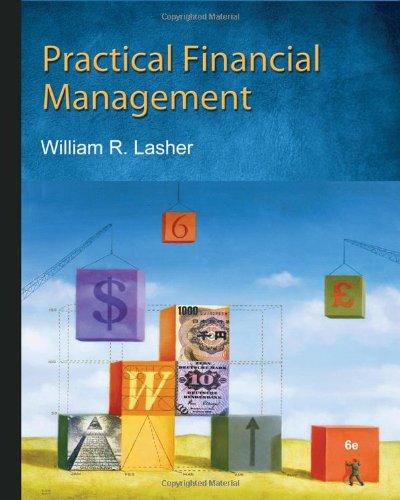Question
Chapter 7 (Introduction to Risk and Return) 1.Investments are generally divided into three distinct groups...treasury bills, bonds, and equities (stocks). Which of the three has
Chapter 7 (Introduction to Risk and Return)
1.Investments are generally divided into three distinct groups...treasury bills, bonds, and equities (stocks). Which of the three has experienced the greatest volatility over the past 100 years yet has provided the highest returns?
A.Treasury Bills
B.Bonds
C.Equities
2.Which of the following is considered the most secure investment but has traditionally yielded a relatively small return?
A.Equities of Blue Chip Companies
B.AAA rated corporate bonds
C.Long Term Government Bonds
D.Short term treasury bills
3.Over the last 100 years, dividend yields have continually declined. What might be a reason for the decline?
A.The intervention by the US Govt in setting interest rates
B.The general decline of stock prices
C.The general increase in stock prices
D.Dividend yields have not been adjusted for inflation
4.The two terms most often used when attempting to measure volatility and risk are:
A.Beta and the Sharpe ratio
B.Beta and Gamma
C.Standard Deviation and Beta
D.Dividend Yields and Earnings per Share
5.What is the relationship between variance and standard deviation?
A.Standard deviation is the square root of the variance
B.Variance is the square root of the standard deviation
C.Standard deviation plus the variance equals beta
D.They have no direct relationship
6.Investors prefer diversified companies because they are less risky
A.True
B.False
7.If stocks were perfectly positively correlated, diversification would not reduce risk
A.True
B.False
8.Diversification over many stocks will eventually completely eliminate risk
A.True
B.False
9.A well-diversified portfolio with a beta of 2.0 is twice as risky as the market portfolio
A.True
B.False
10.In which of the following situations would you get the largest reduction in risk by spreading your investment across two stocks?
A.The two shares are perfectly correlated
B.There is no correlation
C.There is modest negative correlation
D.There is perfect negative correlation
11.There are two major types or risk associated with investing. They are:
A.Financing risk and environmental risks
B.Insurance risk and interest rate risk
C.Unique/specific risk and market risk
D.Market risk and global warming
12.Generally, as you add more stocks to your portfolio you will enjoy a rapid increase in diversification early on followed by a relatively flat pattern.
A.True
B.False
13.Assume you own two stocks, Apple and Microsoft. 70% of your portfolio is in Apple stock and the balance is in Microsoft. Assume further that Apple has a standard deviation of 21.1% and Microsoft has a standard deviation of 32.3%. If we consider the two stocks to be perfectly positively correlated what is the standard deviation of the combined portfolio?
A.21.34%
B.22.18%
C.24.46%
D.28.27%
14.If two stocks have a correlation coefficient of .95 this would indicate that the stock prices have historically had very similar movements. In other words when one increased in value, the other did as well, and generally by similar percentages.
A.True
B.False
Chapter 8 (Portfolio Theory and the Capital Asset Pricing Model)
15.A stock's contribution to the risk of a fully diversified portfolio depends on its sensitivity to market changes. This sensitivity is generally known as beta.
A.True
B.False
16.The Sharpe ratio is used by investors to measure the risk-adjusted performance of investment managers. Assume that the historical return on a specific stock is 10%. Also assume that the standard deviation of that stock is 25% and beta is 1.75. Finally assume that the risk-free rate of return in 1.5%. Based on these factors, calculate the Sharpe Ratio.
A.Cannot calculate without knowledge of dividend yield
B..34
C..40
D.1.0
17.Since 1900 the market risk premium has averaged:
A.Between 0 and 5.0%
B.Between 5.0% and 10%
C.Between 10% and 15%
D.Less than 0
18.The Capital Asset Pricing Model has proven that, in a competitive market, the expected risk premium varies in direct proportion to:
A.Dividend yield
B.Price/Earnings Ratio
C.Earnings per Share
D.Beta
19.In well-functioning markets, nobody should acquire/hold a stock that offers a return less than the market risk premium.
A.True
B.False
20.The starting point of the graph (y axis) of the Security Market Line would be:
A.Market Risk Premium
B.Beta
C.Risk free rate of return
D.Standard Deviation
21.A portfolio that offers the highest expected return for any level of risk is deemed to be:
A.Efficient
B.Diversified
C.Conservative
D.Specialized
22.Assume the historical return for ABC Company is 11.5% and its beta is .5. Further assume that the risk-free rate of return is 3% and the standard deviation is 30%. Based on these factors (using the Capital Asset Pricing Model) calculate the cost of equity.
A.8.5%
B.4.25%
C.6.25%
D.7.30%
Step by Step Solution
There are 3 Steps involved in it
Step: 1

Get Instant Access to Expert-Tailored Solutions
See step-by-step solutions with expert insights and AI powered tools for academic success
Step: 2

Step: 3

Ace Your Homework with AI
Get the answers you need in no time with our AI-driven, step-by-step assistance
Get Started


